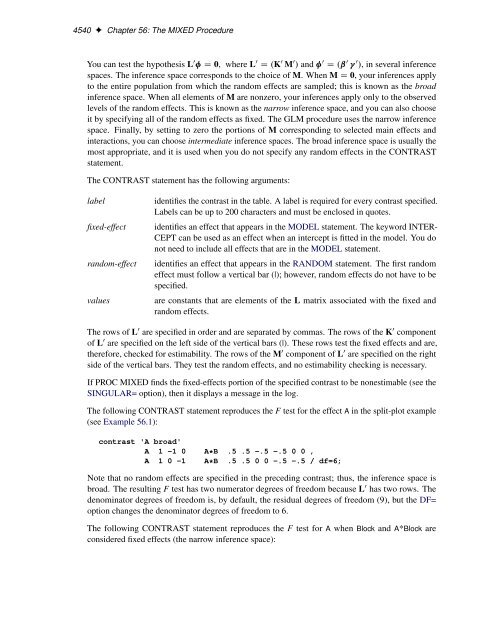SAS/STAT 922 User's Guide: The MIXED Procedure (Book Excerpt)
SAS/STAT 922 User's Guide: The MIXED Procedure (Book Excerpt)
SAS/STAT 922 User's Guide: The MIXED Procedure (Book Excerpt)
Create successful ePaper yourself
Turn your PDF publications into a flip-book with our unique Google optimized e-Paper software.
4540 ✦ Chapter 56: <strong>The</strong> <strong>MIXED</strong> <strong>Procedure</strong><br />
You can test the hypothesis L 0 D 0, where L 0 D .K 0 M 0 / and 0 D .ˇ 0 0 /, in several inference<br />
spaces. <strong>The</strong> inference space corresponds to the choice of M. When M D 0, your inferences apply<br />
to the entire population from which the random effects are sampled; this is known as the broad<br />
inference space. When all elements of M are nonzero, your inferences apply only to the observed<br />
levels of the random effects. This is known as the narrow inference space, and you can also choose<br />
it by specifying all of the random effects as fixed. <strong>The</strong> GLM procedure uses the narrow inference<br />
space. Finally, by setting to zero the portions of M corresponding to selected main effects and<br />
interactions, you can choose intermediate inference spaces. <strong>The</strong> broad inference space is usually the<br />
most appropriate, and it is used when you do not specify any random effects in the CONTRAST<br />
statement.<br />
<strong>The</strong> CONTRAST statement has the following arguments:<br />
label identifies the contrast in the table. A label is required for every contrast specified.<br />
Labels can be up to 200 characters and must be enclosed in quotes.<br />
fixed-effect identifies an effect that appears in the MODEL statement. <strong>The</strong> keyword INTER-<br />
CEPT can be used as an effect when an intercept is fitted in the model. You do<br />
not need to include all effects that are in the MODEL statement.<br />
random-effect identifies an effect that appears in the RANDOM statement. <strong>The</strong> first random<br />
effect must follow a vertical bar (|); however, random effects do not have to be<br />
specified.<br />
values are constants that are elements of the L matrix associated with the fixed and<br />
random effects.<br />
<strong>The</strong> rows of L 0 are specified in order and are separated by commas. <strong>The</strong> rows of the K 0 component<br />
of L 0 are specified on the left side of the vertical bars (|). <strong>The</strong>se rows test the fixed effects and are,<br />
therefore, checked for estimability. <strong>The</strong> rows of the M 0 component of L 0 are specified on the right<br />
side of the vertical bars. <strong>The</strong>y test the random effects, and no estimability checking is necessary.<br />
If PROC <strong>MIXED</strong> finds the fixed-effects portion of the specified contrast to be nonestimable (see the<br />
SINGULAR= option), then it displays a message in the log.<br />
<strong>The</strong> following CONTRAST statement reproduces the F test for the effect A in the split-plot example<br />
(see Example 56.1):<br />
contrast 'A broad'<br />
A 1 -1 0 A*B .5 .5 -.5 -.5 0 0 ,<br />
A 1 0 -1 A*B .5 .5 0 0 -.5 -.5 / df=6;<br />
Note that no random effects are specified in the preceding contrast; thus, the inference space is<br />
broad. <strong>The</strong> resulting F test has two numerator degrees of freedom because L 0 has two rows. <strong>The</strong><br />
denominator degrees of freedom is, by default, the residual degrees of freedom (9), but the DF=<br />
option changes the denominator degrees of freedom to 6.<br />
<strong>The</strong> following CONTRAST statement reproduces the F test for A when Block and A*Block are<br />
considered fixed effects (the narrow inference space):

















